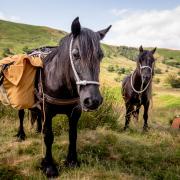The Penwortham-based artist has painted in 150+ countries and shares tips to help you get started

An artist from Penwortham has spent 60 years travelling around the world and has created more than 2000 intricate paintings of the places he has visited.
Martyn Hanks, 79, has visited 152 countries over the last six decades, but instead of taking photographs he painstakingly creates watercolours of his travels, which cover the walls of his home.
His paintings show the everyday lives of people around the world, as well as popular tourist destinations. His watercolours range from farm scenes in Snowdonia and the typical interior of a house in Japan to the building of the Sydney Opera House and the stunning landscape of the Grand Canyon. Other pictures show women sorting stones in Jaflong in Bangladesh, cricketers in Barbados and people washing clothes in Iran.
Martyn, who is now selling his prints online for the first time, said: ‘I’ve got most of my pictures on my walls, I don’t bother with wallpaper. I love travelling and they are a wonderful reminder of everywhere I’ve visited.

‘When I first started travelling in the early 1960s I just painted to pass away a spare hour, but I soon realised I got a lot of pleasure from painting and as the years went on it became my main reason for travelling, giving a real purpose to my trips.’
Whenever he travels, he carries his watercolour paints and brushes and uses a 14 inch by 10 inch canvas as it fits neatly in his rucksack.
Martin, who worked as an architectural model maker throughout his career, paints most of his pictures on the spot and works up the remainder later from quick sketches and photos made at the time.
‘Watercolours are ideal for travelling as they are quick to dry. I’d often put everything in my rucksack, cycle to a particular place and sit and paint with the canvas on my lap,’ he said. ‘It’s lovely to walk a few miles, then stop and see a lovely view and sit down and paint. I find it very therapeutic and I get completely lost in my painting and forget about any problems.’

Martyn, who has never married, took his first trip to France with a friend in 1960 when he was 18-years-old and loved the adventure.
Since then he hasn’t looked back, taking time out from work for an overland trip to Australia, to travel around Scandinavia and to visit China in 1964 when it was just starting to open to tourists. He has also lived and worked in Australia, New Zealand and Saudi Arabia.
‘North Yemen was one of my favourite places to paint as it was just so medieval and had amazing buildings,’ he said. ‘There were lots of people in national dress and it just lent itself to painting. I’ve also been to India five times, it’s a fantastic place to paint and hard to beat.’
Martyn, whose travel plans have been postponed this year due to the coronavirus pandemic, is continuing to paint from photos taken on previous trips during the lockdown.
He added: ‘There’s still a couple of African countries I’d like to visit and I’d love to see a bit more of Indonesia but I feel very content as I’ve been to the bulk of the countries I’d like to see.’
Prints can be ordered from martynhanks.com.
Martyn has painted landmarks and landscapes all over the world. Here are some of his favourites from a little closer to home, and some tips to help you start painting.
Select your spot
Choose somewhere you feel makes a nice composition. And start with something you like. I could have painted Blackpool Tower from other angles, but chose to show it with the beach, the pier and donkeys in the view. They all place the image unmistakeably in Lancashire and give interest to the finished piece.
How to start
I recommend you always have a sketchbook with you and when you see a view you think would work, try to draw it on the spot. It’s not always convenient to sit down and paint. Capture something that appeals to you.
I usually start at eye level and work out where that will be on the picture, then sketch in the background and work from there. Try to work out the perspective and make sure lines that are parallel end up parallel in the finished piece, as in my painting of the Harris Museum at Preston.
What to include
With experience, you’ll get to know which elements to include and which to leave out. When you’re starting, concentrate on the elements that attracted you to that view – the tree, building, or whatever – and work from there.
You might feel an image needs something adding to the foreground – that’s why I practised painting animals and people. They were a weakspot for me, so I worked hard on improving. I took pictures of cows, sheep and other animals and would work from photos until I felt more confident. Now I can add them to the foreground when I need to. My painting of Bowland needed something extra, so I added the family having a picnic.
When to stop
If you sketch the view as quickly as you can while you’re there you will include the key features that attract you to that scene. You can spend too much time adding in things that detract from the finished piece. Capture the key elements and work them up into a painting. Lots of paintings have been ruined by poor drawings, so concentrate on those initial sketches.
My painting of Liverpool’s Anglican Cathedral is one of my favourites. I wanted the building to be the focal point of the painting so I chose a view where it could stand alone.
Top tip: Don’t be too ambitious too soon. Start small and work your way up. Don’t be put off if it doesn’t work straight away. Keep going.




























